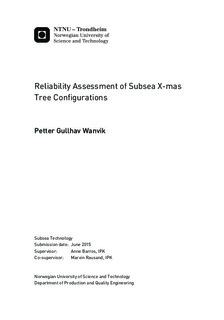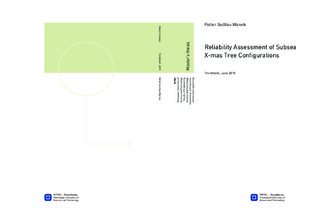| dc.description.abstract | The focus of this thesis is to provide input for choosing the optimal X-mas Tree (XT) configuration for a subsea production system.
The subsea XT is used to direct, regulate, and stop the flow from a well. These functions and some more are achieved through several valves, a subsea control module, and some sensors.
The choke valve has the worst inherent reliability of the components on a XT. Because of this the choke valve is designed for easy retrieval. The choke valve could also be placed in a separate flow control module. The subsea control module is the XT component with the second worst reliability. Both these components are modules because it is good method of improving system maintenance of unreliable components.
The main XT configurations are the vertical XT, the horizontal XT, and the deepwater vertical XT. The main differences are how the main valves are placed and how the tubing with tubing hanger is installed.
In subsea reliability it is common to use mean time to failure as a performance indicator and the exponential distribution to model lifetimes.
A Reliability, Availability, and Maintainability (RAM) analysis is frequently used to analyze the subsea production system. RAM analysis software use reliability block diagrams, flow diagrams, and Monte Carlos next event simulation to simulate the lifetime and the availability of the subsea production system.
Two main sources of reliability data for subsea components are OREDA and SubseaMaster. When applying component reliability data in a RAM analysis, this often give a lower availability than experienced in real life. This could relate to how, from when, or from where the data are collected. Expert judgment can be used to calibrate the data so that the model fit the real life scenario. The sensitivity and uncertainty of assumptions and the analysis should also be considered. The model and analysis can then be used to optimize the reliability of the design.
In OREDA the vertical XT has a lower inherent reliability than the horizontal XT. The low reliability may relate to the large share of older generation vertical XTs installed. Understanding the quality of the data is difficult and decisions should not be taken solely on the basis of unprocessed data.
A key difference between the XT configurations is the maintainability of the tree and the tubing. Wells that are expected to have many tubing failures should be equipped with a horizontal XT and a vertical XT should be on a well with few tubing failures. This is mainly due to the order of which the components are installed as the HXT allows the tubing to be retrieved without retrieving the tree and vice versa for the VXT.
A failure on the wellhead connector will have a large impact on the availability. Interventions on the horizontal XT are done with a blowout preventer. The height of both these components puts more strain on the wellhead than the other XT configurations. Tripping out tubing is one of the more dangerous operations in a well; this combined with the extra strain on the wellhead may cause bad consequences. This may give an advantage for the VXT in a risk perspective.
A horizontal XT with a flow control module will have improved maintainability, but this adds potential leak paths and makes the design more complex. The vertical XT and deepwater vertical XT are easier to retrieve and may be better off with a simpler design without the flow control module.
The deepwater vertical XT is easier to maintain than a vertical XT. It may be a good choice of configuration for wells with a medium amount of tubing failures. The DVXT is more complex and has more leak paths than the other two configurations and may have a higher infant mortality because of this.
OneSubsea help their customers choose XT configuration with a tree selector tool. Ranking the importance of different aspects give an output of how the XT configurations fit this ranking. This gives a good indication of which configuration to choose for a well.
CAPEX and OPEX are important factors in the decision process.
A RAM analysis would give an overall look on the reliability and life cycle cost of the subsea production system. RAM analysis software is able to process the many varying factors that impact the optimal XT configuration for a subsea production system and should be the foundation of the decision process. | |

